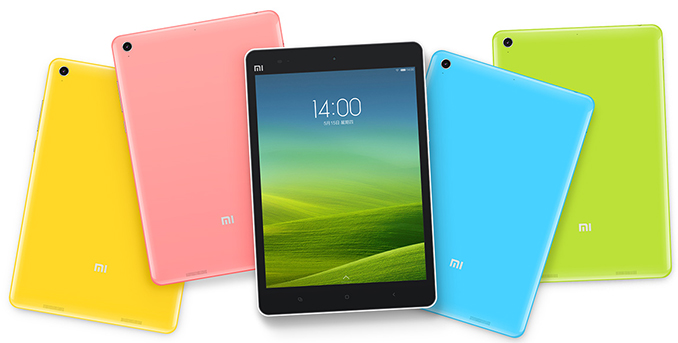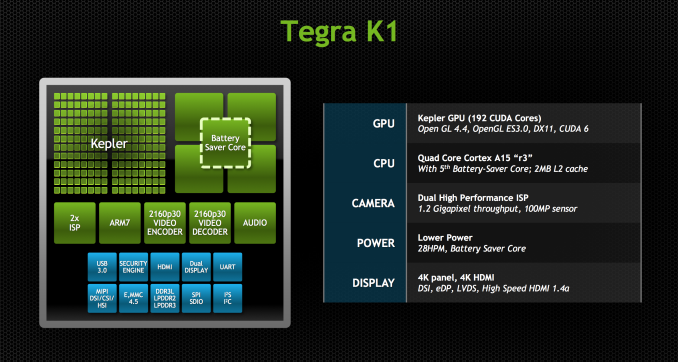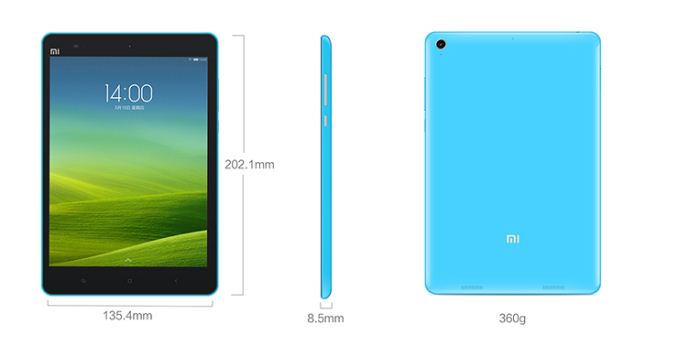Xiaomi Announces the MiPad: The First Tegra K1 Device
by Brandon Chester on May 15, 2014 9:40 AM EST
Today Xiaomi introduced its first tablet: the MiPad. The tablet bears similarity to both Apple’s iPad Mini and iPhone 5c. On the front of the tablet we have a 7.9” 2048x1536 IPS display (sourced from both Sharp and AUO Optronics) which is surrounded by an asymmetrical bezel. On the back we have a plastic shell of multiple different colors which Xiaomi itself states is made with the same injection molding technology as the iPhone 5c. There is also an 8MP Sony camera on the back with an F/2.0 aperture, and a 5MP camera on the front. The most interesting part of the Mi Pad is not on the outside, it's on the inside. The MiPad is the first consumer device to be announced that is powered by NVIDIA's Tegra K1 SoC.
As you may recall, NVIDIA introduced Tegra K1 to the world at CES 2014. It marks a huge departure from NVIDIA's mobile graphics strategy, abandoning the old Tegra GPU roadmap in favor of its desktop Kepler architecture.
Tegra K1 has two flavors, both built on a 28nm HPm process. One uses NVIDIA's Project Denver which will include two custom ARMv8 cores designed by NVIDIA. Denver is not slated to ship until later this year and so what we see in the MiPad is the other flavor of Tegra K1 which is a quad core ARM Cortex A15 design. Similar to other recent Tegra SoCs, this version of the K1 features four Cortex A15s plus an additional companion Cortex A15 optimized for lower frequencies for periods of low CPU usage. The CPU cores are based on a newer revision of Cortex A15 (r3p3) which includes finer grain power gating to reduce power consumption compared to revision r2p1 in the Tegra 4. This increase in efficiency will help balance out NVIDIA's move from a 1.9GHz max clock speed on Tegra 4 to over 2GHz on Tegra K1 (the move to 28nm HPm should help as well). The Tegra K1 SoC in the MiPad will ship with a max clock speed of 2.2GHz and 2GB of LPDDR3 RAM.
The GPU on Tegra K1 is something completely different from previous Tegra designs. Previous Tegra chips integrated NVIDIA's GeForce ULP core designed exclusively for its mobile platforms. With Tegra K1 Nvidia abandoned the idea of having a separate mobile roadmap for GPU designs and has merged its mobile and PC GPU roadmaps. The result is that Tegra K1 and all subsequent designs will ship with GPUs using the same architecture as NVIDIA's PC parts. With Tegra K1 we get a complete implementation of NVIDIA's Kepler architecture with 192 CUDA cores, 4 ROPs, and 8 texture units. It also brings along OpenGL ES 3.0, OpenGL 4.4, DirectX 11, CUDA 6.0, and every other API that Kepler supports.
NVIDIA has also shown a commitment to releasing software that will take advantage of their mobile GPUs. The company recently worked with Valve to bring Half Life 2 and Portal over to the NVIDIA Shield which is powered by a Tegra 4 CPU and I am sure that crafty users will bring the apps over to Tegra K1 devices if NVIDIA does not do so itself.
Beyond the SoC, the other internal specs for the MiPad include a 25.46 Whr (6700mAh) battery, 16 or 64GB of internal NAND, and a MicroSD slot. Connectivity includes support for 802.11 b/g/n/ac and Bluetooth 4.0. As with other Xiaomi devices, the MiPad runs Android with the MIUI UI atop it. It will launch in China sometime in June priced at 1499 yuan ($240) for the 16GB model and 1699 yuan ($272) for the 64GB model.












82 Comments
View All Comments
nafhan - Thursday, May 15, 2014 - link
Uhm... PowerVR has been building graphics chips for about 20 years, too.errorr - Thursday, May 15, 2014 - link
You mean Imagination Technologies which has been focused on low power graphics since 1994. Qualcomm Adreno is the evolution of ATIs embedded graphics product which they purchased. ARM Mali can from falanx a small GPU firm founded in 1998 in Norway And bought by ARM in 2006.All of these companies have been doing low power graphics forever. It is on NV to prove there arch isn't a power-hog/hand-warmer which I'm worried about.
Joel Kleppinger - Thursday, May 15, 2014 - link
That's an ignorant statement. PowerVR / Imagination Technologies is the graphics company that makes the IP for A7's graphics. They have been selling 3D graphics products since 1997 and graphics products in general since 1985. Nvidia was founded in 1993. They are roughly the same age and have roughly the same experience in graphics, though Nvidia's solutions were better for the desktop / high performance use so PowerVR focused on mobile.Spunjji - Friday, May 16, 2014 - link
The A7 graphics are by a company that has been doing graphics exclusively for nearly as long, though. ;)TheJian - Friday, May 16, 2014 - link
It will be facing a 20nm version of K1 by then too. The gap won't change. NV's gpus will start to take over now that they can put their desktops gpu into a SOC with each yearly rev. The driver team's experience at NV and game developer experience working with this hardware will start to show it's teeth this year or next. M1 same time next year (probably a quad denver with maxwell at 20nm). NV pays to dev once for desktop but ends up with R&D for socs done already pretty much. This is perfect timing since Intel's payments run out in 2016, which has paid for all the T1-4 R&D up to this point yearly, giving NV essentially 4 free revs of experience to get it right for K1. T1-4 were losing money, and only a way into the market to delay until this year with K1/Denver/Modem (still waiting for T4i to show, but modem just got certified in Nov2013). They won't need that now that the desktop IS the SOC gpu, just with less SMX.NV is about to start taking Qcom share as gaming really kicks into high gear on mobile. I hope AMD gets a phone/tablet soc out soon to compete as they would have the same advantages of NV and there is room in the market for both to easily add a billion or two PROFIT to their sheets. Qcom makes $6.5B a year and there is a TON more in the market they could get too also. If Google/amazon/Samsung don't start using NV in more devices they should put out more of their own ref designs or just sell them directly for good. Just don't piss off google by forking, keep it straight android. Also ARM will be stealing desktop share as Denver and all the others come with in house CPU's, just as they have already done on the really low end in notebooks (21% gone to arm already). I wouldn't be surprised to see 10-20% desktops go to ARM by xmas 2015 (show up in the 2016Q1 report probably after xmas sales) in the form of a 100-500w box with a GPU from NV in the high-end models (100-300w box general internet/email box I guess, but discrete in 400-500w boxes for gamers also). How fast would a SOC run with a PC CPU type heatsink on it and 100w to work with instead of 6-10w? Good enough to take out $300 dell desktops with no win8 lic, no Intel cpu, etc. So AMD/NV both have a shot at Intel's 10-12B profits also. ARM IP is good enough AMD could take share back via A57's etc on the lower end even with no custom cores.
We need more money at AMD/NV. GPU's like it or not, are becoming more an more important in everything we watch, play etc. There were 100 companies testing NV GRID 2 quarters ago. Last quarter it doubled to 200. This quarter it's 600 companies testing GRID. It's clear we're heading to grid for lots of work (movies, game dev, etc all require rendering farms today), so both AMD/NV have a great growth area or they wouldn't be getting so many people to test this stuff. Clearly they want it.
I couldn't imagine how happy engineers would be if they were waiting for a 5hr drawing/model to render with a single $4000-6000 Quadro etc, then they get access to a VPU farm that is 1000x faster and does it in seconds or minutes. It is much easier to maintain a single box with hardware and all the pro app lics than it is thousands of users so I can see why they want this and would test it. Everybody gets faster rendering etc, and management gets a break.
2X faster and you think A7 is impressive? It was when it came out, yes. But it's not a company that is new. IMG.L, the people that make the gpu in nearly all apple mobile devices (all? - Imagination) have been in the business as long as NV, so really it's a total failure. They were driven OUT of desktops by NV/AMD/Intel. They ran to mobile, and now you're seeing the kings moving to mobile and 1/2 as fast isn't a good result in that light right? Founded in 1985 so longer than NV (1993), but losing. You're mistakenly thinking Apple makes the gpu themselves. Even if they do some of the work, they have a 30yr GPU company backing them with help right? They don't call it an apple gpu.
https://en.wikipedia.org/wiki/Imagination_Technolo...
$12mil in profits last year vs. ~500mil for NV and IMG.L is in every apple device so management can't figure out how to price their product right if you're in the most expensive devices from the company making the most money and you still are broke. They had to borrow money to by mips. NV's licensing of their IP now will take it's toll soon. IMG.L had no real competition until NV said that. I picture samsung/apple licensing NV IP for K1/M1/V1 at some point if they are not able to field their own GPU that can beat them. IMG.L is dead unless someone buys them. It's just a question of how long it takes for people to get out chips on NV IP. I suspect that won't happen until more games get ported etc to android/tegra and we see what K1 games can do. xmas 2015 we'll see people start to realize Mobile is a great replacement for consoles. Raise your hand if you think portal & half life 2 were great games? The audience on 1.2Billion mobile units sold yearly will think the same thing as all of us. Get a few dozen more great titles over there and it will snowball followed with NEW gaming IP funded by the quick easy ports to the huge mobile audience. People will want desktop graphics in their phone/tablet and Apple, Samsung etc will give them whatever sells best.
name99 - Thursday, May 15, 2014 - link
By itself this (2x faster than Apple A7) is not especially interesting. It's trivial to make a faster GPU --- if you are willing to spend the power.The complaint by those who few have had the chance to experiment with K1 is not that it is slow, it's that it's a power hog, unbalanced for the target market. Simply saying that it's 2x as fast without battery life is not helpful.
I find it significant that in the entire Engadget gallery there is no photo giving any sort of battery life information. The whole thing looks exactly like an Apple presentation (no surprise) except it's missing two pieces --- the part at the beginning where Apple tells us they have sold their 10 billionth song, 1 billionth movie, have upgraded iOS 7 to 97% of the customer base etc etc; and the part during the presentation of a new device where they tell us it can watch movies for ten hours, listen to music for two weeks, etc etc.
Make of that what you will...
fivefeet8 - Thursday, May 15, 2014 - link
That's funny, I noticed the battery life information in one of those slides. You can extrapolate what they mean from them fairly easily or go to another site where they did it for you.name99 - Thursday, May 15, 2014 - link
My bad. That's what comes of not being able to read Chinese!Those are impressive numbers. Well done, NV.
skypacer - Thursday, May 15, 2014 - link
battery life information of MiPad (from Xiaomi.com)6700mAh battery,
11 hours online-video,
17 hours reading ebooks,
86 hours music,
1300 hours idle.
Spunjji - Friday, May 16, 2014 - link
I am legitimately excited about this product!